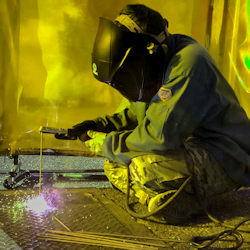Engineering Controls
Engineering controls include local and general exhaust ventilation, process and equipment modification, and isolation or automation.
Exhaust Ventilation: Equip power tools used to remove lead-based paint with dust collection shrouds or other attachments so that paint is exhausted through a high-efficiency particulate air (HEPA) vacuum system. For operations such as welding, cutting/burning, or heating, use local exhaust ventilation. Use HEPA vacuums during cleanup operations.
For more information on ventilation see OSHA Publication 3639, Ventilation in Shipyard Employment.
Containment enclosures: For abrasive blasting operations, build a containment structure that is designed to optimize the flow of clean ventilation air past the workers' breathing zones. This will help reduce the exposure to airborne lead and increase visibility. Maintain the affected area under negative pressure to reduce the chances that lead dust will contaminate areas outside the enclosure. Equip the containment structure with an adequately sized dust collector to control emissions of particulate matter into the environment.
Maersk - World's Biggest Ship: Welding
Enclosure or encapsulation: One way to reduce the lead inhalation or ingestion hazard posed by lead-based paint is to encapsulate it with a material that bonds to the surface, such as acrylic or epoxy coating or flexible wall coverings. Another option is to enclose it using systems such as gypsum wallboard, plywood paneling, and aluminum, vinyl, or wood exterior siding. Floors coated with lead-based paint can be covered using vinyl tile or linoleum.
Process or equipment modification: When applying lead paints or other lead-containing coatings, use a brush or roller rather than a sprayer. This application method introduces little or no paint mist into the air to prevent a lead inhalation hazard.
Isolation: If it is not feasible to enclose and ventilate abrasive blasting operations completely, it may be possible to isolate operations to reduce the potential for lead exposure. Isolation consists of reducing the risk of exposure by keeping employees who are not involved in the blasting operations as far away from the work area as possible.
Click on the links below to see the OSHA 1915 rules regarding exhaust ventilation and examples of equipment modifications.
(a) The provisions of this section shall apply to all ship repairing, shipbuilding, and shipbreaking operations; except that paragraph (e) of this section shall apply only to ship repairing and shipbuilding. Paragraph (g) of this section shall apply only to ship repairing.
(b) Mechanical ventilation requirements.
- (1) For purposes of this section, mechanical ventilation shall meet the following requirements:
- (i) Mechanical ventilation shall consist of either general mechanical ventilation systems or local exhaust systems.
- (ii) General mechanical ventilation shall be of sufficient capacity and so arranged as to produce the number of air changes necessary to maintain welding fumes and smoke within safe limits.
- (iii) Local exhaust ventilation shall consist of freely movable hoods intended to be placed by the welder or burner as close as practicable to the work. This system shall be of sufficient capacity and so arranged as to remove fumes and smoke at the source and keep the concentration of them in the breathing zone within safe limits.
- (iv) Contaminated air exhausted from a working space shall be discharged into the open air or otherwise clear of the source of intake air.
- (v) All air replacing that withdrawn shall be clean and respirable.
- (vi) Oxygen shall not be used for ventilation purposes, comfort cooling, blowing dust or dirt from clothing, or for cleaning the work area.
(c) Welding, cutting and heating in confined spaces.
- (1) Except as provided in paragraphs (c)(3) and (d)(2) of this section either general ventilation meeting the requirements of paragraph (b) of this section shall be provided whenever welding, cutting or heating is performed in a confined space.
- (2) The means of access shall be provided to a confined space and ventilation ducts to this space shall be arranged in accordance with 1915.76(b)(1) and (2).
- (3) When sufficient ventilation cannot be obtained without blocking the means of access, employees in the confined space shall be protected by air line respirators in accordance with the requirements of � 1915.154, and an employee on the outside of such a confined space shall be assigned to maintain communication with those working within it and to aid them in an emergency.
- When appropriate for the conditions, choose blasting techniques that are less dusty than open-air abrasive blasting. These include hydro- or wet-blasting using high-pressure water with or without an abrasive or surrounding the blast nozzle with a ring of water, and vacuum blasting where a vacuum hood for material removal is positioned around the exterior of the blasting nozzle.
- When using abrasive blasting with a vacuum hood on exterior building surfaces, ensure that the configuration of the heads on the blasting nozzle match the configuration of the substrate so that the vacuum is effective in containing debris.
- Ensure that HEPA vacuum cleaners have the appropriate attachments for use on unusual surfaces. Proper use of brushes of various sizes, crevice and angular tools, when needed, will enhance the quality of the HEPA-vacuuming process and help reduce the amount of lead dust released into the air.
Knowledge Check Choose the best answer for the question.
2-3. Which practice is an example of an engineering control to mitigate exposure to lead?
You forgot to answer the question!

